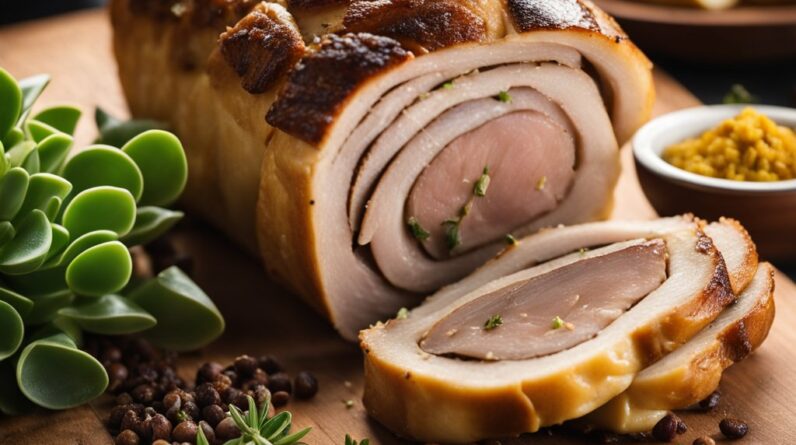Imagine taking a bite of a mouthwatering, authentic Italian sandwich filled with layers of delicious capicola. The combination of flavors, from the rich and tender pork to the perfect blend of spices, transports you straight to the sun-soaked streets of Italy. If you’ve ever wondered how to recreate this traditional cold cut at home, look no further. In this article, we will guide you through the step-by-step process of making capicola, using either pork shoulder or neck, so you can enjoy this flavorful delicacy anytime you want. Get ready to embark on a culinary adventure and impress your friends and family with your homemade Italian cold cut skills!
Choosing the Right Cut of Pork
When making capicola, it is crucial to select the right cut of pork. The two most commonly used cuts for capicola are pork shoulder and neck. Both cuts are well-suited for curing and have enough fat to ensure a flavorful and succulent final product. Pork shoulder, also known as pork butt, is known for its marbling and tender texture, while pork neck offers a richer and more intense flavor. Whichever cut you choose, make sure it is fresh and of high quality, as this will greatly impact the taste and texture of your homemade capicola.
Trimming Excess Fat
Before preparing the meat for curing, it is important to trim any excess fat from the chosen cut of pork. Removing excess fat will not only improve the texture of the capicola but also prevent it from becoming greasy during the curing process. Use a sharp knife to carefully trim away the visible fat, leaving a thin layer to enhance the flavor and moisture of the meat. Take your time and ensure that you remove any tough or sinewy parts as well. By trimming the fat, you can create a well-balanced capicola with just the right amount of richness.
Preparing the Meat for Curing
Once the excess fat has been trimmed, it’s time to prepare the meat for curing. Start by rinsing the pork shoulder or neck thoroughly under cold running water to remove any impurities. After rinsing, pat the meat dry using paper towels, ensuring that it is completely moisture-free. This step is crucial as excess moisture can hinder the curing process and lead to spoilage. Make sure to handle the meat with clean hands and on a clean surface to maintain proper hygiene throughout the preparation process.
Preparing the Cure
To create the perfect cure for your capicola, gather the necessary ingredients. The main components of the cure are salt, sugar, and spices. The salt acts as a preservative, while the sugar balances the flavor and adds a touch of sweetness. As for the spices, it’s traditional to use a combination of crushed peppercorns, garlic, and herbs like thyme or rosemary. Adjust the quantities of each ingredient according to your taste preferences, ensuring a well-rounded and aromatic flavor profile.
Mixing the Salt, Sugar, and Spices
In a bowl, combine the measured amounts of salt, sugar, crushed peppercorns, garlic, and any additional spices or herbs you wish to include. Mix them thoroughly to ensure an even distribution of flavors. The salt and sugar will work together to draw out moisture from the meat, creating a preservation environment for the capicola. The spices and herbs will infuse their essence into the meat, adding depth and complexity to its taste. Take your time and be sure to evenly distribute the spices and herbs in the mixture.
Coating the Meat with the Cure Mixture
Once the cure mixture is properly mixed, it’s time to coat the meat. Place the trimmed pork shoulder or neck in a shallow dish or container. Sprinkle the cure mixture over the entire surface of the meat, making sure to cover it evenly. Using your hands, rub the cure mixture into the meat, ensuring that all sides are thoroughly coated. The salt in the cure will penetrate the meat, drawing out moisture, while the other ingredients will season and flavor it. Be generous with the cure, as it will play a crucial role in the capicola’s taste and preservation.
Curing the Meat
After coating the meat with the cure mixture, it’s time to begin the curing process. Applying the cure is a crucial step to transform the pork into delicious capicola. Place the cured meat in a clean plastic bag or wrap it tightly in plastic wrap, ensuring that no air can enter or escape. This airtight environment will allow the curing process to occur effectively. Once wrapped, transfer the meat to the refrigerator and allow it to cure for a specific period, usually around one to two weeks. During this time, the meat will undergo chemical changes, resulting in the flavorful and textured capicola.
Drying and Aging
Once the curing period is complete, it’s time to move on to the next phase: drying and aging the capicola. Carefully unwrap the meat, discarding any excess cure mixture. Rinse the meat under cold water to remove any remaining surface salt. Pat it dry once again, ensuring it is completely moisture-free. To aid in the drying process, hang the meat in a cool, dry place with good air circulation, such as a basement or a dedicated curing chamber. This will allow the capicola to develop a desirable texture and concentrate its flavors over time.
Monitoring and Adjusting Humidity Levels
During the drying and aging process, it is important to monitor and adjust the humidity levels to ensure optimal results. Ideally, the humidity should be kept around 60-70% to prevent the meat from drying too quickly or becoming excessively moist. High humidity levels can promote mold growth, while low humidity levels can cause the meat to become too dry and lose its desired texture. Regularly check the humidity levels and use a humidifier or dehumidifier if necessary. This will help create the ideal environment for the capicola to dry and age properly.
Flavoring and Seasoning
Once the capicola has reached the desired texture through drying and aging, it’s time to add some final touches in terms of flavor and seasoning. Begin by applying a generous layer of ground black pepper to the exterior of the cured meat. The pepper will add a pleasant heat and enhance the overall taste of the capicola. Additionally, you can experiment with other optional seasonings such as crushed red pepper flakes, fennel seeds, or smoked paprika to tailor the flavors to your preferences. Massage these seasonings onto the meat, ensuring they adhere well and evenly coat the capicola.
Wrapping and Pressing
To ensure a well-shaped and compact capicola, it is essential to wrap and press it properly. Start by covering the flavored and seasoned capicola with a layer of cheesecloth. This will protect the surface and prevent any unwanted exposure during the final steps. Next, place the capicola between two clean cutting boards or flat surfaces. Apply gentle pressure to the top cutting board to compress the meat. Finally, add a weight, such as a heavy book or a makeshift press, on top of the capicola to create an even and uniform shape. Leave the capicola pressed for a few hours or overnight in the refrigerator.
Aging and Fermentation
After the pressing stage, the capicola enters the final phase of aging and fermentation. Hang the capicola in a controlled environment, such as a cool cellar or aging chamber, where the temperature remains between 55-60°F (12-16°C). Allow the capicola to hang undisturbed for a designated time period, usually around 4-6 weeks. During this time, the capicola will continue to develop its flavor and texture. The aging process allows the flavors to deepen while any remaining moisture evaporates, resulting in a rich and concentrated capicola that is ready to be enjoyed.
Slicing and Serving
After the recommended aging period, it’s time to unveil your homemade capicola and enjoy its deliciousness. Start by removing the cheesecloth and gently brushing off any excess seasoning. Using a sharp slicing knife, carefully slice the capicola into thin, uniform pieces. The thin slices will accentuate the capicola’s tender texture and make it easier to incorporate into various dishes. Serve your sliced capicola on sandwiches, in pasta dishes, or as part of an antipasto platter. Its rich flavor and delicate marbling will undoubtedly add a touch of authentic Italian goodness to any culinary creation.
Storing and Shelf Life
To prolong the shelf life of your homemade capicola, it is important to store it properly. Wrap the sliced capicola tightly in plastic wrap or place it in an airtight container to protect it from exposure to air and moisture. This will help maintain its flavor and prevent spoilage. The capicola can be refrigerated, where it will stay fresh for up to two weeks. Alternatively, you can freeze it for longer-term storage. When properly stored, capicola can be enjoyed for several months, retaining its flavor and quality throughout.
Variations and Recipe Adaptations
While the traditional capicola recipe is undoubtedly delicious, don’t be afraid to explore variations and adapt the recipe to suit your tastes. Experiment with different spices or herbs to create unique flavor profiles. You can use crushed coriander seeds, juniper berries, or even a hint of cinnamon to add an unexpected twist. Additionally, consider trying different cuts of meat to create distinct capicola variations. Beef or wild game like venison can be excellent substitutes for pork and offer a unique flavor experience. Embrace the creativity and diversity of Italian cuisine by trying traditional regional variations and exploring your own culinary journey.









